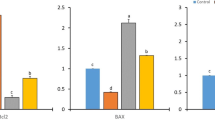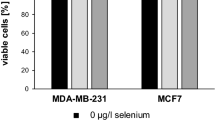Abstract
Using the dimethylbenz(a)anthracene-induced mammary tumor model in rats, our studies indicated that there was a dose-response relationship between dietary selenium supplementation and the inhibition of mammary carcinogenesis. The degree of inhibition was proportional to the level of dietary selenium up to 5 ppm, at which point toxicity in the form of a reduction in weight gain was evident. Moreover, it was observed that the chemopreventive efficacy of selenium was influenced by the dose of carcinogen as well as the fat intake of the animals. By supplementing selenium for defined periods of time, we concluded that selenium inhibited both the initiation and the promotion phases of chemical carcinogenesis, and that a continuous intake of selenium was necessary to achieve maximal suppression of tumor growth. In an attempt to improve the efficacy of lower levels of selenium, we conducted another series of experiments in which selenium and vitamin E were tested in combination. Results showed that although vitamin E alone had no prophylactic effect against tumorigenesis, it potentiated the ability of selenium to inhibit the development of mammary tumors. Further investigation suggested that the anticarcinogenic action of selenium could not be explained by its antioxidant function in lipid peroxidation. On the other hand, vitamin E might be able to provide a more favorable climate against oxidant stress to facilitate selenium in exerting its inhibitory effect through some other mechanisms.
Similar content being viewed by others
References
G. N. Schrauzer, D. A. White, and C. J. Schneider,Bioinorg. Chem. 8, 387 (1978).
G. N. Schrauzer, J. E. McGinness, and K. Kuehn,Carcinogenesis 1, 199 (1980).
D. Medina and F. Shepherd,Cancer Lett. 8, 241 (1980).
D. Medina and F. Shepherd,Carcinogenesis 2, 451 (1981).
H. J. Thompson and A. R. Tagliaferro,Fed. Proc. 39, 1117 (1980).
H. J. Thompson and P. J. Becci,J. Natl. Cancer Inst. 65, 1299 (1980).
C. Ip and D. Sinha,Carcinogenesis 2, 435 (1981).
C. Ip,Cancer Res. 41, 2683 (1981).
C. Ip,Cancer Res. 41, 4386 (1981).
C. W. Welsch, M. Goodrich-Smith, C. K. Brown, H. D. Greene, and E. J. Hamel,Carcinogenesis 2, 519 (1981).
M. M. Jacobs, B. Jansson, and A. C. Griffin,Cancer Lett. 2, 133 (1977).
B. K. Soullier, P. S. Wilson, and N. D. Nigro,Cancer Lett. 12, 343 (1981).
M. M. Jacobs, C. F. Forst, and F. A. Beams,Cancer Res. 41, 4458 (1981).
J. R. Harr, J. H. Exon, P. H. Weswig, and P. D. Whanger,Clin. Toxicol. 6, 487 (1973).
A. C. Griffin and M. M. Jacobs,Cancer Lett. 3, 177 (1977).
M.V. Marshall, M. S. Arnott, M. M. Jacobs, and A. C. Griffin,CancerLett. 7, 331 (1979).
R. J. Shamberger,J. Natl. Cancer Inst. 44, 931 (1970).
S. Wilt, M. Pereira, and D. Couri,Proc. Am. Assoc. Cancer Res. 20, 21 (1979).
G. A. Greeder and J. A. Milner,Science 209, 825 (1980).
J. A. Milner and C. Y. Hsu,Cancer Res. 41, 1652 (1981).
C. Ip and D. Sinha,Cancer Res. 41, 31 (1981).
C. Ip,Cancer Res. 40, 2785 (1980).
S. Young and R. C. Hallowes, Tumors of the Mammary Gland, inPathology of Tumors in Laboratory. Animals, Vol. 1,Tumors of the Rat. Part 1, V. S. Turusov, ed., Lyon, IARC 1973, p. 31.
T. L. Dao, D. Sinha, S. Christakos, and R. Varela,Cancer Res. 35, 1128 (1975).
C. lp, P. Yip, and L. L. Bernardis, Cancer Res.40, 374 (1980).
C. lp and M. M. Ip,J. Natl. Cancer Inst. 66, 291 (1981).
H. Ohkawa, N. Ohishi, and K. Yagi,Anal. Biochem. 95, 351 (1979).
D. G. Hafeman, R. A. Sunde, and W. G. Hoekstra,J. Nutr. 104, 580 (1974).
M. S. Wortzman, H. J. Besbris, and A. M. Cohen,CancerRes. 40, 2670 (1980).
W. G. Hoekstra,Fed. Proc. 34, 2083 (1975).
G. N. Schrauzer and D. A. White,Bioinorg. Chem. 8, 303 (1978).
A. H. Daoud and A. C. Griffin,Cancer Lett. 5, 231 (1978).
T. Lawson and D. Birt.Proc. Am. Assoc. Cancer Res. 22, 93 (1981).
J.E. Spallholz, J. L. Martin, M. L. Gerlach, and R. H. Heinzerling,Proc. Soc. Exp. Biol. Med. 143, 685 (1973).
J.E. Spallholz, J. L. Martin, Mo L. Gerlach, and R. H. Heinzerling,Infect. Immun. 8, 841 (1973).
J. E. Spallholz, J. L. Martin, M. L. Gerlach, and R. H. Heinzerling,Proc. Soc. Exp. Biol. Med. 148, 37 (1975).
Author information
Authors and Affiliations
Rights and permissions
About this article
Cite this article
Ip, C. Selenium-mediated inhibition of mammary carcinogenesis. Biol Trace Elem Res 5, 317–330 (1983). https://doi.org/10.1007/BF02987217
Received:
Accepted:
Issue Date:
DOI: https://doi.org/10.1007/BF02987217




